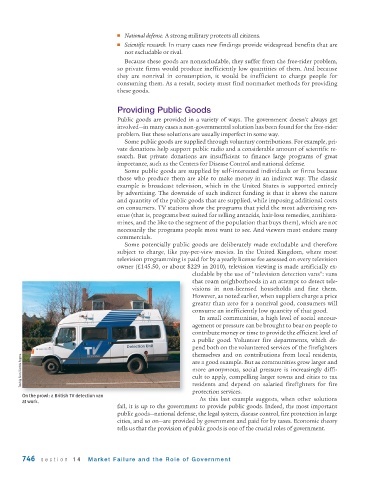Page 788 - Krugmans Economics for AP Text Book_Neat
P. 788
■ National defense. A strong military protects all citizens.
■ Scientific research. In many cases new findings provide widespread benefits that are
not excludable or rival.
Because these goods are nonexcludable, they suffer from the free-rider problem,
so private firms would produce inefficiently low quantities of them. And because
they are nonrival in consumption, it would be inefficient to charge people for
consuming them. As a result, society must find nonmarket methods for providing
these goods.
Providing Public Goods
Public goods are provided in a variety of ways. The government doesn’t always get
involved—in many cases a non-governmental solution has been found for the free-rider
problem. But these solutions are usually imperfect in some way.
Some public goods are supplied through voluntary contributions. For example, pri-
vate donations help support public radio and a considerable amount of scientific re-
search. But private donations are insufficient to finance large programs of great
importance, such as the Centers for Disease Control and national defense.
Some public goods are supplied by self-interested individuals or firms because
those who produce them are able to make money in an indirect way. The classic
example is broadcast television, which in the United States is supported entirely
by advertising. The downside of such indirect funding is that it skews the nature
and quantity of the public goods that are supplied, while imposing additional costs
on consumers. TV stations show the programs that yield the most advertising rev-
enue (that is, programs best suited for selling antacids, hair-loss remedies, antihista-
mines, and the like to the segment of the population that buys them), which are not
necessarily the programs people most want to see. And viewers must endure many
commercials.
Some potentially public goods are deliberately made excludable and therefore
subject to charge, like pay-per-view movies. In the United Kingdom, where most
television programming is paid for by a yearly license fee assessed on every television
owner (£145.50, or about $229 in 2010), television viewing is made artificially ex-
cludable by the use of “television detection vans”: vans
that roam neighborhoods in an attempt to detect tele-
visions in non-licensed households and fine them.
However, as noted earlier, when suppliers charge a price
greater than zero for a nonrival good, consumers will
consume an inefficiently low quantity of that good.
In small communities, a high level of social encour-
agement or pressure can be brought to bear on people to
contribute money or time to provide the efficient level of
a public good. Volunteer fire departments, which de-
pend both on the volunteered services of the firefighters
themselves and on contributions from local residents,
Touhig Sion/Corbis Sygma are a good example. But as communities grow larger and
more anonymous, social pressure is increasingly diffi-
cult to apply, compelling larger towns and cities to tax
residents and depend on salaried firefighters for fire
protection services.
On the prowl: a British TV detection van
at work. As this last example suggests, when other solutions
fail, it is up to the government to provide public goods. Indeed, the most important
public goods—national defense, the legal system, disease control, fire protection in large
cities, and so on—are provided by government and paid for by taxes. Economic theory
tells us that the provision of public goods is one of the crucial roles of government.
746 section 14 Market Failure and the Role of Gover nment

